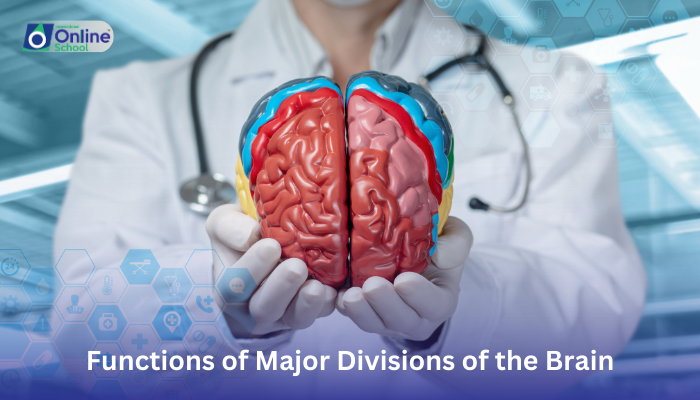
Learning Outcomes:
i. Identify and describe the major divisions of the brain: Cerebrum, Cerebellum, Brainstem, and Thalamus.
ii. Explain the key functions of each brain division, highlighting their roles in various physiological processes.
iii. Understand the interconnectedness of different brain parts and their importance in creating a unified mind and body.
Introduction:
Imagine the brain as a magnificent palace, where different departments work together to keep the kingdom running smoothly. In this lesson, we'll explore the major divisions of this palace – the cerebrum, cerebellum, brainstem, and thalamus – and discover the specialized tasks each performs, ensuring the harmony of our thoughts, movements, and vital functions.
i. The Cerebrum: The Grand Hall of Thought and Creativity
The cerebrum, the largest and most complex part of the brain, is like the bustling marketplace of ideas and imagination. It's divided into two hemispheres, each specializing in different functions:
Right Hemisphere: Handles creativity, spatial awareness, and emotional processing. Think of it as the artist, painting vivid pictures and evoking feelings.
Left Hemisphere: Responsible for language, logic, and analytical thinking. Imagine it as the scholar, deciphering words, solving problems, and making sense of the world.
ii. The Cerebellum: The Master of Balance and Coordination
The cerebellum, tucked beneath the cerebrum, is like the palace dance instructor, ensuring smooth and graceful movements. It coordinates muscle activity, maintains balance, and helps us learn new motor skills. Imagine it as the acrobat, performing feats of agility, keeping us upright and in control.
iii. The Brainstem: The Gatekeeper of Life's Essentials
The brainstem, connecting the brain to the spinal cord, is like the palace guard, responsible for vital functions like breathing, heart rate, and sleep. It also relays messages between the brain and the body, ensuring our internal systems are working in harmony. Imagine it as the vigilant sentry, keeping the kingdom safe and running smoothly.
iv. The Thalamus: The Information Hub
The thalamus, nestled deep within the brain, acts as the palace messenger, relaying sensory information from our eyes, ears, and other senses to the relevant departments. It also plays a role in sleep, consciousness, and attention. Imagine it as the postman, delivering vital messages to the right corners of the palace.
v. The Interconnected Symphony: A Unified Mind and Body
The brain doesn't work in isolation; its divisions are like instruments in a grand orchestra, each contributing their unique melody to create the symphony of our being. The cerebrum analyzes information, the cerebellum orchestrates movements, the brainstem keeps us alive, and the thalamus connects everything. This interconnectedness allows us to perceive, think, feel, and act as a whole, a unified mind and body in perfect harmony.
The brain's major divisions are not just independent departments; they are a team of skilled professionals, each playing a crucial role in the grand performance of our lives. By understanding their functions, we gain a deeper appreciation for the remarkable complexity and interconnectedness of the human brain, the maestro's palace where the symphony of our existence is composed and conducted. So, the next time you blink an eye, take a breath, or solve a problem, remember the silent collaboration within your brain, each division working in unison to keep you alive, aware, and connected to the world around you.